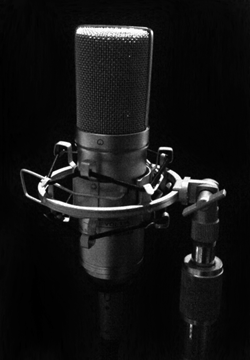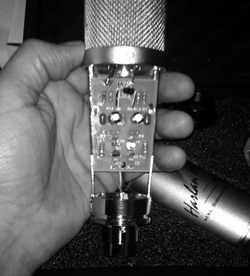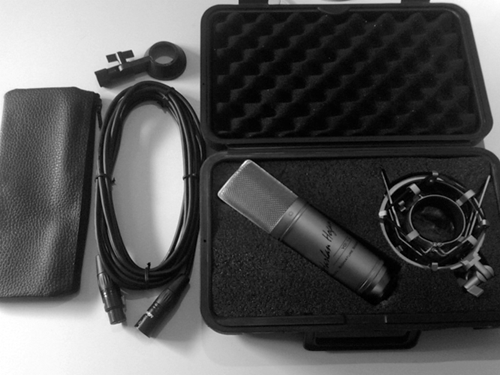 by Steve Cunningham
by Steve Cunningham
Harlan Hogan is not just a world-renowned voice actor, with a string of credits that goes back several decades and includes brands like Raid, Heinz Catsup, and Life Cereal. He’s also a teacher of voiceover talent and an author of several voiceover books. Naturally, one of the most frequent questions asked by his students is “which microphone should I buy?” As an audio engineer and college professor who teaches recording, I get the same question myself quite often. It can be tough to answer, since there are so many good sounding inexpensive condenser microphones to choose from today.
Harlan decided to take a different approach: Why not design a condenser microphone with voice acting in mind? So Harlan commissioned MXL, the brand name used by Southern California-based Marshall Electronics for their broad line of studio and live performance microphones, to create for him a microphone that was designed specifically for voice actors. His signature VO:1-A mic, a large diaphragm condenser that retails for $199 including accessories, and presents in a good-looking nickel finish with Harlan’s signature prominently displayed across the body, is the subject of this month’s product review.
SIGNATURE MODEL
A product of the partnership between MXL and the tag team of Harlan Hogan and his engineer, Jeffery P. Fisher, the MXL VO:1-A is a large diaphragm cardioid condenser microphone which utilizes a 32mm capsule in a standard side address configuration. Measuring 1.85 inches in diameter and 7.2 inches in height, the VO:1-A is nicely finished in champagne colored nickel plating. At about 1 1/3 pounds it’s heavy enough to feel substantial, but not so heavy as to cause a microphone boom to sag. A metal rail surrounds the wire mesh screen that protects the capsule. Directly behind the wire mesh appears to be a very thin layer of foam, no doubt to protect the capsule from moisture during use. For recording voiceover tracks, a pop filter is mandatory with this microphone but, since almost no one seems to include one, or even the old-fashioned foam windscreen, you’ll need to purchase a proper pop filter separately.
The MXL VO:1-A is packaged in standard MXL fashion. A black, poly plastic box with two latches is lined with foam that is precut to fit both the microphone and its included spyder-style shock amount. A particularly nice touch is the extra set of elastic bands that is included specifically for that shock mount. A separate cardboard box contains a fifteen-foot Mogami microphone cable, a zippered leatherette fleece-lined pouch large enough to hold the microphone, and a fixed microphone stand adapter.
Of course I took VO:1-A apart (although I did not attempt to delve further by removing the small screws that would allow me to extract the capsule). The VO:1-A microphone follows the type of internal construction used in many Chinese built microphones, where two metal rails run the length of the microphone, supporting both the circuit boards and the XLR connector. Like most MXL microphones, the tubular body sleeve is held in place by a machined locking ring around the XLR jack, which is further secured by another knurled ring, this one in anodized black, that is designed be removed when using the included fixed mic adapter. When these two rings are removed, the tubular body sleeve slides off to reveal two fiberglass circuit boards attached to the aforementioned rails. All electronic components mounted on these boards are discrete, and the microphone’s output stage is balanced and transformerless. The XLR jack mounted at the bottom features gold-plated pins to help ensure a good connection.
Along with bipolar transistors for handling the required phantom power, I was pleased to see a pair of JFET transistors on the circuit board being used for class-A amplification. I have seen some microphones at this price level utilize op amps for signal conditioning and amplification inside the mic. While this may save a few dollars in parts, an op amp does not sound nearly as good does a JFET transistor, which mimics the characteristics of a tube more than any other solid-state device.

THE SPECS
This mic’s claimed frequency response is from 30 Hz to 20 kHz, with a sensitivity of 18mV/Pa, which is typical for this class of microphone.
It does have a frequency bump in the high-end, which I’ll discuss in a moment. The maximum SPL is rated at 130 dBSPL which is not as high as some, but perfectly adequate for any voiceover job. The microphone’s equivalent input noise is 16dBA; this is not as low as it might be, but is quite respectable and is in fact lower than several other well-known brands in this price range. The overall signal-to-noise ratio comes in at 78dB (A-weighted).
Physically, the VO:1-A appears closest to the MXL992 cardioid microphone, which also features a 32mm capsule. Unlike the 992, the VO:1-A is a straightforward, no-frills microphone that has no external pad or low-frequency roll off switches. As it turns out, it needs neither.
So what is different about the VO:1-A from other MXL studio microphones? What allows it to claim that it is designed specifically for voiceover performers? There are few differences relative to other microphones from MXL. It’s been my experience that most MXL condenser microphones have a significant bump in presence at around 8 to 10kHz. The VO:1-A is no exception, as its frequency response rises at 9kHz. However, the rise is a smooth one rather than a peak or a jump in the high frequencies. Low frequencies actually roll off smoothly, beginning right around 100Hz.
In use the microphone provides a nicely balanced sound with a bit of high-end crispness, but much less than I have found in other MXL microphones. The low-end is present and certainly meaty enough for Big Voice male voiceover, but the proximity effect was not nearly as pronounced as I had expected it to be. Curious as to how this was possible, I checked the polar pattern chart included with the microphone. While the VO:1-A is certainly a cardioid condenser, its polar pattern veers toward being omnidirectional.
This would explain the microphone’s lack of proximity effect. True omnidirectional microphones have no proximity effect, since that effect is generally a byproduct of how cardioid mics create their polar pattern. Cardioid dynamic microphones are ported in such a way that sounds arriving from the side of the capsule are partially canceled out by sounds reaching the capsule from the front. Cardioid condenser microphones mimic that porting process in the way the diaphragm and plate are electrically charged, but the result is fundamentally the same. In both cases, the amount of cancellation of low frequencies is greatly reduced when the sound source is very close to the capsule, hence the bass boost one gets when one is closer than 12 inches from the microphone’s diaphragm.
This is not to say that the VO:1-A has no proximity effect. It will in fact get suitably big if you get right up on the capsule. I would instead say that it’s probably more forgiving for inexperienced talent who haven’t yet mastered the use and control of proximity. The same cannot be said for plosives; this microphone has a high enough sensitivity that plosives will still bite you in the butt if you’re not using a suitable pop filter.
I had several opportunities to test the VO:1-A with both male and female voice talent. Overall, I would have to say that I preferred the VO:1-A over several of the mics in this price range that I have recommended to voice talent in the past. Yes, the slight presence bump is evident. One female voice artist with whom I work regularly has a sibilance issue. I expected she might have a problem with the VO:1-A in that regard, and indeed she did. But she was the exception -- I recorded two other female talents, and that same presence bump imparted a rather pleasant sheen to their tracks. Male voice talent sounded universally good. The low midrange response of the VO:1-A is solid without being in any way tubby. The microphone handled high energy, high volume reads with aplomb, never getting harsh or crashy with them.
I connected the microphone to both tube and solid-state preamplifiers, and it required no more gain than I would’ve expected of a phantom powered condenser microphone. Right around 30dB of gain resulted in a strong, healthy signal level for all but the intimate reads. Since the mic does have some character of its own, I preferred using the solid-state FMR Really Nice Preamp as a front end, although it also sounded quite good through the preamps in a standard issue Digidesign Mbox 2.
Self-noise in this microphone appeared to be on par or slightly better than other sub-$200 microphones I have tested. In particular, the VO:1- A is noticeably quieter than the Audio Technica AT2020, a microphone I had recommended to students on many occasions. But for general voiceover work, including soft and intimate reads, noise was not an issue during my evaluations. It should be noted that there are many postings on recording forums regarding modifications to MXL microphones that allegedly improve their noise performance. These modifications were quite popular with owners of earlier versions of MXL products. But the company has improved the overall noise performance of their microphones across the board in the past few years.
Finally, the VO:1-A is not is not a color-free microphone. It does have a personality, one that I found in most cases to be flattering on voiceover tracks. The combination of solid but controlled low end along with some high-end sheen was usually exactly what the doctor ordered.
As mentioned earlier, the VO:1-A has a bit of heft that is not in any way heavy. This turns out to have a benefit that never occurred to me -- I’ve set up a number of home studios for voice actors, and many of them like to work with the desktop mic stand topped by a short boom.
It is often the case that extending even a 12-inch boom causes the stand to become unstable when you’ve mounted the mic on it. The weight of the VO:1-A is just about right so that does not occur. Nicely done.

The information page for this microphone on Harlan’s website features a link that promises more information on a USB version of the VO:1-A. I was apprehensive when I saw the link, since many USB microphones are inferior to their standard XLR cousins... the noise performance is normally significantly worse. So I was pleased to see that there is no USB version of VO:1-A; rather, Harlan recommends the MicPort Pro USB to XLR converter. This is the only converter of which I’m aware that actually sounds good, and would make a killer addition for a travel rig that included the VO:1-A.
Currently the only way to acquire one of these microphones is directly from Harlan Hogan’s voiceoveressentials.com website. As a voice actor Harlan obviously understands that choosing a mic is a very personal process, so he offers a generous refund policy to give artists time to audition the microphone, in addition to MXL’s three-year warranty. The VO:1-A carries suggested retail price of $199 US. For more information worldwide, visit www.voiceoveressentials.com.
♦

